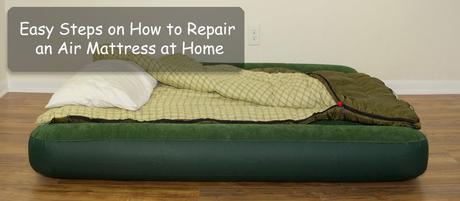Because of the nature and construction of them, it is important to know how to repair an air mattress at home. Most people use their air mattresses for years without experiencing a leak, but it can happen. There are several causes of such leaks, such as a fault in the air pump or a puncture.

Any sharp object can puncture an air mattress, particularly when inflated to a fairly hard level where there is little give in the plastic. Pets lying on them, children playing on them and sharp objects pressing into them. The more highly inflated the air bed, the more likely it is to puncture. With some airbeds, the seams can also fail.
Note that air mattress manufacturers may insist that you repair an air mattress only with their own patch kits, or that you return the mattress for repair. To ignore this may lead to your warranty being void. Check the terms and conditions relating to mattress leaks and repairs before proceeding.
Table of Contents
Finding the Leak
First, you must find the puncture or source of the leak. This can often be a difficult task because even a pinprick can cause an air mattress to deflate. Finding the source of the air leak can sometimes be very difficult. The problem may lie with a faulty pump or valve. Inflate the mattress if you still can, and put your ear as close to the pump or valve as possible - check for hissing air.
If the leak is due to a faulty built-in pump or valve then you will need to either get a warranty repair or order a replacement. You will not be able to repair a faulty pump or valve yourself unless you are skilled in this type of work.
The following tips on how to patch an air mattress relate to punctures in the mattress itself. So, first find the leak! There are several ways of doing this:
- Carry out a visual inspection of the mattress for any obvious holes or splits.
- Feel for the escaping air on the back of your hands - this will be easier if you wet the back of your hands first.
- Look for bubbles: rub soapy water over the mattress and look for air bubbles in the soap. To do this add about a teaspoon of dishwashing liquid to a liter of water. Sponge this solution down the seams and over areas of the mattress that appear worn. Look for bubbles, and if none, do the same on all the sides and main top and bottom surfaces.
- Listen for escaping air.
This procedure is summarized in the following table:
Looka) Check the deflated mattress first - you may be able to find the source of the puncture.
b) Particularly check over any areas of the mattress that appear worn, abraded or damaged.
Inflate the mattress then feel for air blowing out onto your hands.
You are more likely to feel escaping air if you wet your hands, then check while pressing on the mattress to force air out through the hole.
If the above fail to identify the source of the leak, then
a) Deflate the mattress then rub over it with soapy water.
b) Inflate the mattress and look for soap bubbles appearing - this will identify the site of the leak.
If you still fail, then inflate the mattress then press on it with an ear close to the surface. You should be able to hear a slight hissing or whistling sound from the puncture site.
If you have tried all of these and still cannot identify the source of the leak, then inflate the mattress again and put it into a bathtub or pool. You may have to immerse a portion of the mattress at a time if it is too big for the bathtub. You should now be able to spot bubbles as you squeeze on the mattress to force air out of the puncture site.
If you are having difficulty, it often pays to stand your mattress up on a bottom edge against a wall when inflated. You can check three of the sides and one top surface this way, and also get your ear closer. Another good way to detect escaping air is to wet your lips by licking them, then run them across and down, close to the mattress surface. Your lips are more sensitive than your hands.
Many punctures happen on the bottom side of an air mattress, and leaks can also be found at the seams - the four sides of the mattress and round the valve and pump areas. You can normally feel air escaping around the valve by holding your hand round it - particularly if you wet your hand first. The back of your hand is the most sensitive part for detecting the movement and coolness of escaping air.
Once you have found the leak:
- Wipe down the area of the leak then draw a circle around then puncture with a marker pen. Once the mattress is deflated, it may be impossible for you to find the puncture again unless you mark it.
- Deflate the mattress and thoroughly dry off the surface at the puncture site.
- Sandpaper the surface if your air mattress is flocked. A smooth plastic surface need not be scored. This is to ensure a good seal between the patch and mattress surface.
- Seal the puncture as below using a patch or puncture kit.
How to Patch an Air Mattress
1. Using a Supplied Patching Kit
Your mattress might come with a patching kit - not all do, although you could request one if you have a leak. Choose a patch that allows at least a centimeter (roughly half-inch) all round the hole. So for a pinprick puncture, a 2cm or 1" circular patch would be fine. If you only have rectangular patches, cut the corners so they are round - the patch will be less likely to curl at the edges with rounded corners.
Make sure the area to be patched is completely dry then apply the adhesive according to the instructions that come with it. There are various types of adhesive: some are cements that are applied then the patch pressed on while wet. Others are contact adhesives that require the adhesive to be applied to both surfaces, allowed to dry then press together.
Press the patch firmly over the puncture to ensure there are no air bubbles beneath it. If you are using a wet cement rather than dried contact adhesive, then you can exclude air bubbles by turning the patch with a circular motion wile you press, thus breaking up any air bubbles that may form. Make sure the edges are firmly pressed down and adhering properly to the mattress surface.
2. Bicycle Repair Kit
If you have not been provided with patching it with your mattress, you can you can purchase one or use a bicycle repair kit. The patches that come with these bicycle repair kits are suitable for repairing air mattresses. The procedure is much the same as repairing a punctured tire. They normally come with a contact adhesive - so use the same procedure as above.
3. Using a DIY Patch
If you have no patching kit and no bicycle repair kit available, you might not want to wait until you can get one. In an emergency situation such as this, you can carry out a DIY repair. Here is one way how to repair an air mattress at home without regular patches.
Find a thin plastic that can be manually stretched. Examples are a thin tarpaulin or a shower curtain. If you have an air mattress and ever have to change your shower curtain, it might pay to keep the old curtain (or a clean part of it) in a cupboard for use when your mattress gets a puncture.
When you have to use it, cut out a rough circle about 2 cm (just under an inch) across. Flatten it out - use cool iron if you need to. Apply superglue or Gorilla glue or a layer of contact adhesive to the area to be patched, then apply the circle of the shower curtain. Push it well onto the mattress, making sure there are no air bubbles. Smooth it out and then wait until it hardens. You can also apply a contact adhesive such as Evo-stik to the patch and the mattress surface. Wait until they dry and then press the patch firmly onto the mattress. (you can also use Evo-stik with regular bicycle patches.)
4. Reinflate and Test
In either of the cases above (supplied patches-bicycle repair kit- DIY) wait for the recommended time before inflating the mattress. Make sure the patch is properly adhering all round the edges and there are no obvious air bubbles beneath it. Inflate the mattress slowly, and once inflated check the patched area for leaks using any of the above leak-detection methods. If all is OK then you are done.
A professional trick to checking for leaks at this point is to sprinkle talcum powder over the patch. Any air escaping while inflating will cause some of the talcum to blow off the surface. The talc will also adhere to any undried glue - so you can also use it to check for this before inflating.
NOTES: Do not use duct tape for a permanent fix, but you can use this or self-adhesive repair patches in an emergency. These patches might not provide as permanent a repair as using an adhesive or glue, but they are excellent in an emergency when you need your mattress back immediately. Do not use hot glue, such as animal glue. This can melt the air mattress and make it irreparable.
How to Repair an Air Mattress at Home: Summary
There are a few ways how to patch an air mattress effectively. You must first identify the source of the air leak - this may be a leaking valve, a puncture or a split seam. Once you have identifies the site of the leak, you can use a manufacturer's patching kit, a bicycle repair kit or even do it yourself using a shower curtain or some other thin plastic.
The important factors are making sure you have identified all the sources of the leak (there might be more than one), that you have patched or sealed the puncture correctly and that you can reinflate and use the mattress without further air leaks.
You now know how to achieve all this, so not only follow the instructions exactly but understand the basic concepts of how to repair an air mattress at home effectively and without breaching your warranty (if that is important to you.)

